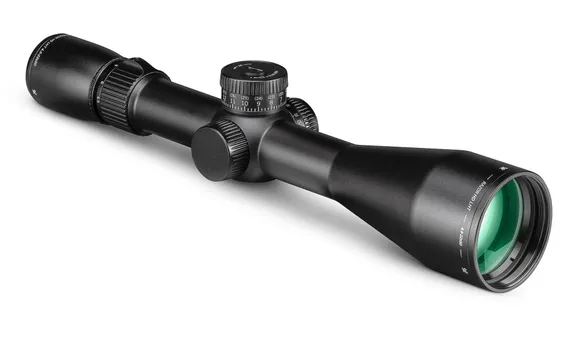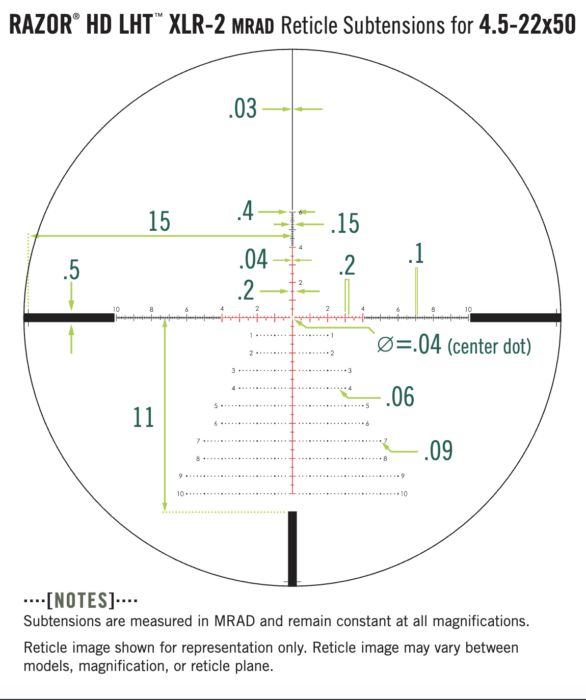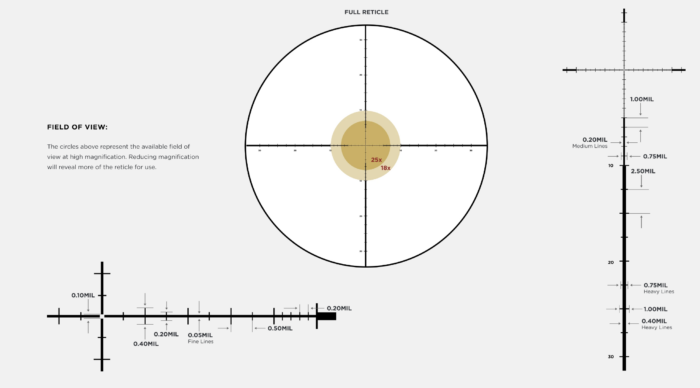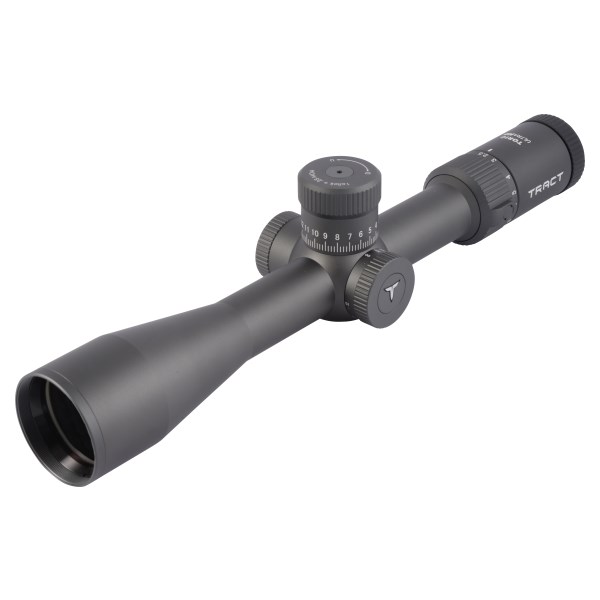Riflescope design and market appeal are a little like Goldilocks’ beds and porridge, swinging from too basic (second-plane duplex reticles in 3-9×42 configurations) to too complicated (first-plane precision reticles in monster 5-30×56 configurations).
But happily the industry has recognized a just-right combination of precision and simple. Here are four new scopes that can do an adequate job in precision-rifle steel matches and are at home in the wide-open game lands of the West, where hunters might have to take a fast shot at an elk or an antelope out beyond 400 yards.
Compared with 34mm behemoths, these are sized-down scopes that fit the new class of lightweight backcountry rifles, but bring enough precision attributes, in the form of first-plane reticles and exposed tactical turrets, that both shooters and hunters can confidently place first shots at distance. Even better, these are scopes that are designed for fast shooting, with relatively uncluttered reticles and excellent glass to enable quick target acquisition.
The value proposition of these scopes is that target shooters can spend the off-season ringing steel and getting to know the reticles and turret operation in the controlled chaos of a PRS match, and then take that working knowledge to the mountains during big-game season. By bringing both precision and hunting chops to the game, these Goldilocks scopes are actually excellent values since they enable two very different types of shooting in one product.
Vortex Razor HD LHT in 4.5-22×50

The OG of this category is Vortex’s Razor HD LHT in 4.5-22×50. Originally designed to appeal to Western hunters who have a solid background in precision shooting and familiarity with first-plane reticles, the LHT has since become a darling of the precision rimfire world, and it remains an excellent mid-sized scope in centerfire PRS matches. While it’s a couple years old, it’s worth adding to this roster because it does so many things so well.
Its first-plane tree-style reticle is available in either MIL or MOA configurations. Its elevation turret is lockable, meaning you need to pull to turn it, a feature that should appeal to hunters worried about the inadvertent movement of turrets in the field. Its 30mm tube and 50mm objective lens fit on a variety of lightweight rifles; the scope itself weighs a svelte 21 ounces.

Other worthy attributes are an excellent zero stop, which ensures a quick return to your pre-selected zero, very good Japanese glass, and side parallax that focuses targets from just 25 yards to well beyond your shooting ability. A free ballistic turret is also included with purchase, which means you can tune the elevation turret to your specific load dynamics.
There are a few dings on this venerable scope. The first is that the reticle may be too busy for many dynamic hunting situations. Second, the first-plane reticle is hard to see at lower magnifications, and is overly large at the highest magnifications. I’d say the sweet spot is between about 8- and 15-power.
The second shortcoming won’t matter much to shooters who hold over (for elevation) or off (for windage), but those who dial for shooting corrections may be disappointed in the relatively paltry turret adjustment. The Razor HD LHT has 22.4 MRAD/75 MOA of elevation adjustment, significantly less than its 30mm peers.
But this may be the best example of a true target/hunting scope in our test. Vortex has taken the premium optics and precise reticle of its top-of-the-line target scope—the Razor HD Gen II—and taken away heft and bulk to fit just about any hunting rifle or field situation.
The very name—Light Hunter Tactical—gets at its versatility, and on a per-pound basis, the Vortex may be the most feature-packed scope on the market. At $2,199 MSRP and about $1,380 real-world pricing, the Razor LHT is a significant investment. But few other scopes offer this amount of precision hunting and target features in such a lightweight and nimble package.
Leupold Mark 5HD 2-10×30

Not all these Goldilocks scopes are configured for far-distant shooting and hunting. Leupold’s new Mark 5HD 2-10×30 is really designed as a mid-distance carbine scope, but it’s a remarkably versatile platform that can transition from precision rimfire work to deer hunting anywhere and even mid-range steel and 3-Gun competitions.
The new Mark 5HD, which descends from the Marines’ Dedicated Marksman platform, belongs on just about any AR platform, but it’s equally at home on a straight-wall lever gun or a bolt-action deer rifle. The heart of the scope is its hash-style first-plane TMR reticle, which is available with or without illumination, and which is also available in either MIL or MOA versions. The reticle is simple enough to enable snap shots but has enough granularity to place precise shots in slow-fire situations.
The glass is great, the configuration lends itself to low-profile mounting options, and the side focus ramps from 40 yards to infinity. The elevation turret is defined by Leupold’s Zero Lock dial, which can be upgraded to a Custom Dial System; the windage turret is capped.

You’re not going to win many extreme-range target competitions with this scope, but it’s a marvel at rimfire precision and mid-range target games, and easily transitions from bear season to elk country, spending the rest of its time atop a truck gun.
The 35mm tube is a bit of a pain, since it limits mounting options, and we noted that at the lowest magnification the reticle isn’t visible. But those are small quibbles for a new scope that can do so many tasks very well.
Toric UltraHD 2.5-15×44

A relatively new player in the direct-to-consumer optics category, Tract introduced its crossover Toric UltraHD 2.5-15×44 to the world by very explicitly stating that it is a Western big-game scope. But along the way, we’ve discovered that it’s also an excellent .22 target scope, a killer squirrel scope, and will hold its own in just about any long-range target game.
The hash-style reticle in the first focal plane is a big reason for the Tract’s versatility. The Hunting Reticle is available in either MRAD or MOA configurations, and is designed to aid bullet-drop compensation and range estimation. In the MRAD version, the reticle is divided into .5 MRAD marks with larger 1 MRAD marks for quick reference, and .25 MRAD grids on the upper and side posts can be used for precise target measurement. In the MOA version, those marks are rendered in 1, 5, and .5 MOA references.

Priced under $1,000, the Toric has a zero stop, capped windage and exposed (and very tactile) pull-to-turn elevation turret. Because it’s built on a 30mm tube with a 44mm objective, it can be mounted low on hunting rifles. Side parallax ranges from 10 yards to infinity, and optional reticle illumination costs an extra $70.
At the highest magnifications, the reticle’s center aiming point can obscure targets, and similarly we noted that at lowest magnifications, the non-illuminated reticle is hard to see. But the scope tube enables a whopping 100 MOA (30 MRAD) elevation adjustment, and its relatively light 28-ounce weight makes it very nimble. With a matte graphite finish, the Tract is a stylish, responsive, and fairly priced package that will help turn in good mid-range steel scores, but is built for the field.
Revic Acura RS25i 5-25×50

Any discussion of cross-over hunting/target scopes has to include the newest member of the Goldilocks fraternity. It’s the Revic Acura RS25i 5-25×50 from the optics branch of the precision-gun company Gunwerks. This scope was purpose-built to bridge the gap between target work and hunting, and performs both tasks masterfully.
The scope is built around the first-plane RH2 MOA-based reticle that is defined by a bold post with a smallish MOA ranging grid and relatively large windage hashes. That gets at the utility of the Acura; it’s designed to be dialed for distance and held for wind, a system that’s fast and precise and dominates fast-action Western big-game hunting. The exposed elevation turret is tuned with Revic’s Ballistic Data Ring. Basically, you range your target, then turn the dial and receive aiming solutions in yardage or MOA references.

Visual “wind assist icons” show wind direction and which direction to hold to account for wind drift. The 30mm tube has abundant internal adjustment range, and the scope integrates with the Revic/Gunwerks ballistic app and long-range precision ecosystem. Other attributes are excellent Japanese glass, a tool-less rezeroable turret with adjustable zero stop, and wide field of view.
At $2,195, it’s a serious investment, but it’s a serious long-range hunting instrument that is built to bring home any trophy animal, and will probably win its share of long-range target competitions, too.
Read the full article here

